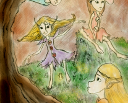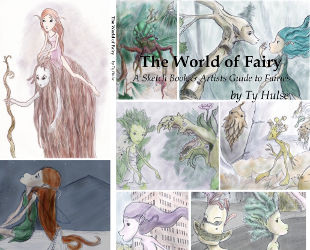 |
Dedicated
to the study of the fairies in fairy tales
.
 |
Fairy
Tale Stories Children's
Fairy Tales Blog About Fairy List Encyclopedia
Fairies lend their good name to some of the greatest of tales, yet when many people search for the original meaning behind fairy tales the role that belief in fairies played in society is often forgotten. This is a guide to understanding what people believed fairies were so that you can better understand the fairy tales they inhabit.
The
word fairy can be tied originally to a general concept of
"fatedness." Because they control human fate from secret it was believed that firies existed in a freer state then humans, able to to change shape, turn invisible, appear and disappear at will (Jacod Grimm). Becasue of their magical knowledge and capabilities fairies can be said to live in a hidden world along side the human world - living under stoves, at thresholds, within trees, rocks, mountains, caves, lakes, in invisible castles, underground worlds or realms in the sky. Read a Synopsis on the Types of Fairies
Read
Article Relation Between Humans and Fairies.
Categories of Fairies Nature
spirits Read Article Tree Fairies
Read Article Forces of Nature
Perhaps the most common and important fairies were the water fairies. Read Article Water Fairies
Read Article Fairies of the Land Read ArticleAnimals Spirits Read ArticleDeities of the past Many
of the fairies which haunt Europe are likely deities of the past who
became lesser beings after another people or religion took over the
region. Charles Squire maintains that many of the fairy beings of
Ireland are the divinities of the pre-Celtic peoples who inhabited that
kingdom who were lessened when the Celts invaded. Specifically he
states that: “The leprechaun, who makes shoes for the fairies and
knows where hidden treasures are, the Gan Ceanach, or "love-talker" who
fills the ears of idle girls with pleasant fancies when to merely
mortal ideas they should be busy with their work; the pooka, who leads
travellers astray, or taking the shape of an ass or mule, beguiles them
to mount upon his back to their discomfiture; the Dulachan, who rides
without a head, and other friendly or malicious spirits. Whence come
they? A possible answer suggests itself. Preceding the Aryans and
surviving the Aryan conquest all over Europe was a large, non-Aryan
population which must have had its own gods who would retain their
worship, be revered by successive generations, and remain rooted to the
soil.” (Maccullock, 1911) I |
Fairy Tales Home Fairies フェアリー Norse-Franco-German Fairy Tales Norse Franco German Fairies Gernan Fairy Tales Swedish Fairy Tales Norwegian Fairy Tales French Fairy Tales & More tales Celtic Fairy Tales Celtic Fairies Welsh Fairy Tales Irish Fairy Tales & More Tales Fairy Blog Fairy Songs Origins of Europes Fairies & More Fairy Articles Finno-Baltic-Siberian Fairy Tales Finno-Baltic-Siberian Fairies Finnish Mythology Estonian Mythology Mari-el Fairy Tales & More Tales Greco-Roman Mythology Greco-Roman Fairies Greek Fairy Tales Roman Mythology Slavic Mythology Slavic Fairies Russian Fairy Tales Polish Fairy Tales & More Tales Tales of Other Lands Fairies of Other Lands Japanese Fairy Tales Chinese Folktales & More Tales Fairy Tales for Kids Children's Dutch Fairy Tales Fairy Tales Every Child Should Know Fairy Art |





